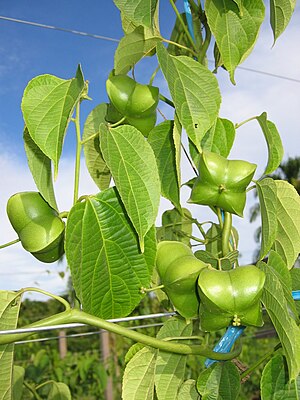Plukenetia volubilis
| Plukenetia volubilis | ||||||||||||
|---|---|---|---|---|---|---|---|---|---|---|---|---|

Plukenetia volubilis |
||||||||||||
| Systematics | ||||||||||||
|
||||||||||||
| Scientific name | ||||||||||||
| Plukenetia volubilis | ||||||||||||
| L. |
Plukenetia volubilis , also known as sacha inchi or Inca nut , is a climbing plant from the spurge family from the subfamily of the Acalyphoideae, in the tribe of the Plukenetieae in the subtribe of the Plukenetiinae. It comes from tropical, northern South America and is used as an oil plant.
Plukenetia conophora from West Africa is very similar, but it has rounded seeds.
description
Plukenetia volubilis becomes about 2.5 meters or more long or high, it is semi-herbaceous and trailing . The alternate and stalked, underneath lighter, slightly leathery leaves are up to about 10-13 inches long and egg-shaped, they are more or less serrated or serrated on the edge and the tip is rounded or pointed to pointed or tailed. The bald petiole is up to 6 inches long. The leaf base is blunt to truncated and usually more or less heart-shaped. The veins are threefold and the blade is slightly hairy on the underside of the veins. The leaf stalks have one or two rounded glands at the leaf base. Small stipules that fall off early are present or they are absent entirely.
Plukenetia volubilis is mostly monoecious , the male and female flowers are axillary, short-stalked and thyrsic inflorescences. The hermaphroditic, mixed inflorescences each have very few (1–2) female flowers at the base of the inflorescence. The small, short-stalked, usually four-fold and unisexual, greenish flowers have a simple flower cover , the petals are missing. The female sepals are very small, the male are up to 4 millimeters long. The male flowers have many (20-30) and very short stamens , the female flowers have a top permanent and mehrteiligen-, lobed, small ovary with a long, thick and cylindrical, bare pen with four- to six-part scar .
Usually four- to six-part, star-shaped and short-winged, ribbed, about 4-6.5 centimeters in size, slightly warty, leathery and practically smooth, brownish capsule fruits with a persistent style when ripe are formed, which open at the tip. The brown and rounded to egg-shaped, mostly flattened, thin-skinned and hard, slightly veined seeds (nuts) in the separate compartments are up to 1.5-2 centimeters in size and often have short wings on the median side.
Systematics
It was first described in 1753 by Carl von Linné in Species Plantarum 1192. Synonyms are Fragariopsis paxii Pittier , Plukenetia macrostyla Ule , Plukenetia peruviana Müll.Arg. , Sajorium volubile (L.) Baill.
use
The seeds and leaves are edible. An oil is extracted from the seeds, which is used in cosmetics and as an edible oil.
literature
- A. Engler , F. Pax , K. Hoffmann: The plant kingdom. IV. 147, IX-XI, volume 68, Euphorbiaceae-Acalypheae-Plukenetiinae , Engelmann, 1919, p. 14 f, online at Biblioteca digital del Real Jardín Botánico de Madrid.
- Lynn J. Gillespie: A Synopsis of Neotropical Plukenetia (Euphorbiaceae) Including Two New Species. In: Systematic Botany. Vol. 18, No. 4, 1993, pp. 575-592, doi: 10.2307 / 2419535 .
- J. Lanjouw, AL Stoffers: Flora of Suriname. Vol. II, Part 2, Brill, 1976, ISBN 90-04-04581-3 , p. 411.
- Yan Luo, Bang-Zhen Pan, Lu Li, Chen-Xuan Yang, Zeng-Fu Xu: Developmental basis for flower sex determination and effects of cytokinin on sex determination in Plukenetia volubilis (Euphorbiaceae). In: Plant Reproduction. 33 (1), 2020, doi: 10.1007 / s00497-019-00382-9 .
- José Roque Gamarra: Seven vascular plants species used in Peru: Factsheet botanical. In: Arnaldoa. 20 (2), 2013, pp. 359-432, online at researchgate.net.
Web links
- Plukenetia volubilis at Useful Tropical Plants.
